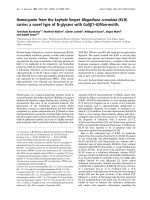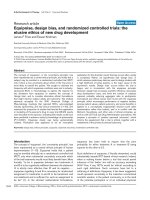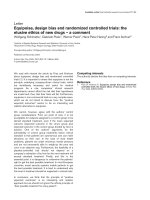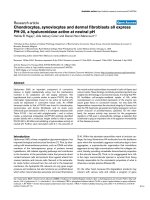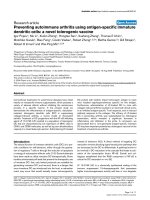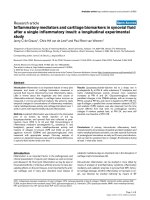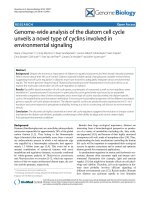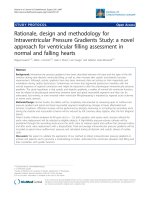Báo cáo y học: "Rationale, design and methodology for Intraventricular Pressure Gradients Study: a novel approach f" doc
Bạn đang xem bản rút gọn của tài liệu. Xem và tải ngay bản đầy đủ của tài liệu tại đây (440.93 KB, 6 trang )
STUDY PROT O C O L Open Access
Rationale, design and methodology for
Intraventricular Pressure Gradients Study: a novel
approach for ventricular filling assessment in
normal and falling hearts
Miguel Guerra
1,2†
, Mário J Amorim
3†
, João C Mota
2
, Luís Vouga
2
and Adelino Leite-Moreira#
1,3*
Abstract
Background: Intraventricular pressure gradients have been described between the base and the apex of the left
ventricle during early diastolic ventricular filling, as well as, their increase after systolic and diastolic function
improvement. Although, systolic gradients have also been observed, data are lacking on their magnitude and
modulation during cardiac dysfunction. Furthermore, we know that segmental dysfunction interferes with the
normal sequence of regional contraction and might be expected to alter the physiological intraventricular pressure
gradients. The study hypothesis is that systolic and diastolic gradients, a marker of normal left ventricular function,
may be related to physiological asynchrony between basal and apical myocardial segments and they can be
attenuated, lost entirely, or even reversed when ventricular filling/emptying is impaired by regional acute ischemia
or severe aortic stenosis.
Methods/Design: Animal Studies: Six rabbits will be completely instrumented to measuring apex to outflow-tract
pressure gradient and apical and basal myocardial segments lengthening changes at basal, afterloaded and
ischemic conditions. Afterload increase will be performed by abruptly narrowing or occluding the ascending aorta
during the diastole and myocardial ischemia will be induced by left coronary artery ligation, after the first diagonal
branch.
Patient Studies: Patients between 65-80 years old (n = 12), both genders, with severe aortic stenosis referred for
aortic valve replacement will be selected as eligible subjects. A high-fidelity pressure-volume catheter will be
positioned through the ascending aorta across the aortic valve to measure apical and outflow-tract pressure before
and after aortic valve replacement with a bioprosthesis. Peak and average intraventricular pressure gradients will be
recorded as apical minus outflow-tract pressure and calculated during all diastolic and systolic phases of cardiac
cycle.
Discussion: We expect to validate the application of our method to obtain intraventricular pressure gradi ents in
animals and patients and to promote a methodology to better understand the ventricular relaxation and filling and
their correlation with systolic function.
* Correspondence:
† Contributed equally
1
Faculty of Medicine of University of Oporto, Department of Physiology,
Alameda Professor Hernâni Monteiro, 4202-451 Porto, Portugal
Full list of author information is available at the end of the article
Guerra et al. Journal of Cardiothoracic Surgery 2011, 6:67
/>© 2011 Guerra et al; licensee BioMed Central Ltd. This is an Open Access article distributed under the terms of the Creative Commons
Attribution License ( which permits unrestricted use, distribution, and reproduction in
any medium, provided the origin al work is properly ci ted.
Background
Normal diastolic function of the left ve ntricle (LV) can
be defined as the ability of the ventricle to adequately
fill under low filling pressures. The hallmark of diastolic
dysfunction is the impaired capacity to fill or maintain
stroke volume without a compensatory increase in filling
pressures [1,2]. Study of diastolic LV function should
primarilybeinspiredbytheimpact that diastolic dys-
function has on symptoms and prognosis . Actually, dia-
stolic dysfunction is present in a number of cardiac
diseases and often precedes LV systolic dysfunction,
leading to symptoms of heart failure in patients with
preserved systolic function [3].
As early as 1930, Katz [4] already speculated that dia-
stolewasnotentirelyapassiveprocessandtheLVhad
the ability to “ exert a sucking action to draw blood into
its chamber.” But it was only in 1979 that Ling et al. [5]
first described, in a canine model, intraventricular pres-
sure gradients (IVPG) during relaxation and filling of the
LV. In 1988, Courtois et al. [6] observed, also in a canine
model, a significant sub-basal-apical early diastolic pres-
sure gradient along the LV inflow tract with minimum
pressure in the a pex speculating suction of the blood
toward the LV apex. When subsequent ly it was shown
that these g radients were diminished by ischemia and
related to systolic function [7], the concept that they
reflected recoil was born. Moreover, when Nikolic et al.
[8] in 1995 demonstrated IVPG during early diastole in
filling as well as in non-filling heart beats, the hope that
IVPG would become an index for isovolumic and early
ventricular relaxation was substantiated.
Therefore to describe LV diastolic function comprehen-
sively, it is crucial the precise characterization of the trans-
mitral and intraventricular pressure-flow relation. Early
diastole is not am enable to analysis with simple passive-
filling models, and any complete description of diastole
must account for ventricular suction and for the presence
of regional pressure oscillations which play an important
role in normal ventricular filling [9]. In fact, the observa-
tion that the apical region fills first and begins to oscillate
while filling is still occurring in the basal region is consis-
tent with a model of diastolic function in which it can be
inferred that suction is completed earlier near the a pex
than near the base [6,7]. Later [10], it was also demon-
strated that in both animals and humans the pressure gra-
dient between the ventricular apex and outflow tract
strongly correlated with peak early transmitral flow and
stroke volume and markedly increased during volume
loading and decreased during reduced LV filling by caval
constriction. Furthermore, in 2001, Firstenberg et al. [11]
confirmed the existence of IVPG during early diastolic fill-
ing in humans and demonstrated that improvements in
LV systolic and diastolic function, through surgical myo-
cardial revascularization and/or LV remodeling, result in
increases in IVPG. In fact, the same group has shown in
patients with hypertrophi c cardio myopat hy that diastolic
IVPG are lower than in healthy subjects and improve after
percutaneous septal ablation [12]. Although systolic IVPG
has been also observed between the LV apex and the sub-
aortic area [10], data are lacking on the magnitude of
these gradients and its modulation during systolic and dia-
stolic function impairment. Actually, regional ischemia
interferes with the normal sequence of regional contrac-
tion and might be expected to alter the physiological dia-
stolic and systolic IVPG.
These observations suggest the c ritical importance of
IVPG to ensure efficient LV diastolic filling and allow us
hypothesizing that any condition which interferes with
the normal sequence of regional relaxation might be
expected to change the physiological IVPG pattern.
Actually, several studies have demonstrated that LV
function is nonuniform in healthy hearts [13,14]. Peak
shortening is larger in the lateral wall than in the sep-
tum and increases from the base to apex [15]. Besides
variations in the degree of shortening, variations in the
timi ng of shortening have been reported including early
onset and late peak of shortening in the lateral wall
[16]. Moreover, mechanical interaction between different
myocardial segments has been studied extensively dur-
ing regional ischemia, a condition in which regional
myocardial function of the ischemic segment is
decreased but that of the adjacent normal myocardium
may be increased [17,18]. Understanding the origin of
normal regional differences in LV myocardial function
may give insight in pathological nonuniformities.
A variety of other disorders are associated with diasto-
lic dysfunction, such as hypertrophy, structural altera-
tions of the myocardium with increased fibrosis,
myocardial scarring, or infiltrative processes [19]. In
addition to these changes, physiological abnormalities of
the LV with impaired relaxat ion, decreased diastolic fill-
ing, and increased stiffness of the myocardium can be
observed [20]. In patients with aortic stenosis (AS), the
most common cause for diastolic dysfunction is LV
hypertrophy [21,22]. In subjects with asymptomatic
severe AS, increased LV mass index was found to be an
independent predictor for the development of symptoms
[23]. Although it has been previous ly shown that aortic
valve replacement (AVR) may lead to immediate hemo-
dynamic improvement and to prolongation of survival
[24,25], it has been reported that regression of myocar-
dial hypertrophy after relief of the hemodynamic burden
is a process that may continue for decades after AVR
[26]. However, abnormal exercise hemodynamics may
persist late after AVR despite a normal systolic response
[27], suggesting impaired diastolic function in these
patients which may be revealed by acute and early IVPG
alteration.
Guerra et al. Journal of Cardiothoracic Surgery 2011, 6:67
/>Page 2 of 6
Despite the apparent importance of IVPG in diastolic
function evaluation, they have never been utilized in
clinical cardiology, due to the complexity of their acqui-
sition. Whereas regional pressure differences between
the LV, the LV outflow tract, and the aorta during ejec-
tion have been recognized for some time [28], the
importance of regional pressure differences within the
ventricle during diastole and systole has only recently
gained attention. Moreover, LV dysfunction may be
underestimated when only LV ejection fraction is evalu-
ated. Actually, tissue Doppler imaging [29] and 2-
dimensional strain [30] analysis of longitudinal myocar-
dial function have shown to be superior in detecting
subtle deteriorations of contractility. However, metho-
dology to provide means for earlier diagnosis of global
or regional myocardial disease remains an issue of study
and necessary research [31-33].
In conclusion, we hypothesize that systolic and diasto-
lic IVPG, a marker of nor mal left ventricular function,
may be related to physiological asynchrony betwee n basal
and apical myocardial segments and that they can be
attenuated, lost entirely, or even rever sed when ventric u-
lar filling/emptying is impaired by acute regional ische-
mia or pressure overload, such as severe aortic stenosis.
Objectives
Animal studies
1) Characterize IVPG along t he cardiac cycle (systole
and diastole);
2) Evaluate the effects of the ischemia and modulation
by afterload;
3) Correlate the IVPG with myocardial segmental
asynchrony, in basal, afterloaded and ischemic
conditions.
Patient studies
1) Validate the invasive measurement of IVPG for systo-
lic and diastolic function evaluation in patients with
severe AS;
2) Apply this methodology to evaluate whether the
IVPG improve in AS patients immediately after AVR;
3) Establish if IVPG changes correlate with the reduc-
tion in LV obstruction and improvement in LV
function;
4) Correl ate catheter measurements with preoperative
echocardiography;
5) Evaluate the potential clinical applicability of the
concepts derived from the experimental studies.
Methods and Design
Animal studies
The investigation conforms to the Guide for the Care
and Use of Laboratory Animals published by the US
National Institutes of Health (NIH Publication No. 85-
23, Revised 1996).
Animal preparation
Male New Zealand White rabbits (Oryctolagus cuniculus,
n = 6) are premedicated with ketamine hydrochloride
(50 mg/kg im) and xylazine hydrochloride (5 mg/kg im).
A femoral vein is cannulated, and a solution containing
20meqKCland40meqNaHCO
3
in500mlof0.9%
NaCl is administrated at a rate of 8 ml·kg
-1
·h
-1
to com-
pensate for perioperative flu id losses. A tracheostomy is
performed, and mechanical ventilation is initiated (Har-
vard Small Animal Ventilator, model 683), delivering
oxygen-enriched air. Respiratory rate and tidal volume
are adjuste d to keep arteria l blood gas es and pH with in
physiological limits. Anesthesia is maintained with a per-
fusion of midazolam (0.07 mg·kg
-1
·h
-1
), fentanil (0.003
mg·kg
-1
·h
-1
) and vecuronium (0.1 mg·kg
-1
·h
-1
). A 20-
gau ge catheter is inser ted in the right femoral artery and
connected to a pressure transducer to monitor heart rate
and arterial pressure and to obtain sam ples for blood gas
analysis. The heart is exposed by a median sternotomy,
and the pericardium is widely o pened. One silk suture is
placed around the ascending aorta and then passed
through a plastic t ube to perform transient aortic occlu-
sions during the experimental protocol. A limb electro-
cardiogram (DII) is recorded throughout.
Pressure measurements
Two 3-F high-fidelity micromanometer (SPR-524, Millar
Instruments, Houston, Tex., USA) are inserted through
an apical puncture wound into the LV cavity. One is
pulled carefully back toward the endocardium and
secured in place with a purse-string s uture to measure
apical LVP. The other is introduced until we can see the
impact from the aortic valve on the pressure trace. The
catheter then is pulled back 5 mm below the aortic
valve so that it is located in the LV outflow-tract to
measure basal LVP. The pressure transducers are cali-
brated against a mercury column and zeroed after stabi-
lization for 30 min in a water bath at bo dy temperature.
The zero is set at the level of the right atrium. Record-
ings are made with respiration suspended at end expira-
tion. Parameters are converted on-line to digital data
with a sampling frequency of 1 kHz. LV pressures are
measured at end-diastole (LVPED), at pressure nadir
(LVP
min
) and at peak systole (LVP
max
). Peak rates of LV
pressure rise (dP/dt
max
) and pressure fall (dP/dt
min
), as
well as, time to dP/dt
min
are measured too. Relaxation
rate are estimated with the time constant tau (τ)byfit-
ting the isovolumetric pressure fall to a monoexponen-
tial function. We pretend to record continuously IVPG
as apical minus outflow-tract LVP. Peak and average
(area) IVPG are calculated during diastolic and systolic
phases of cardiac cycle.
Sonomicrometry
Regional ventricular function is measured with two pairs
of ultrasonic segment length gauges implanted in the
Guerra et al. Journal of Cardiothoracic Surgery 2011, 6:67
/>Page 3 of 6
circumferential direction of apical and basal left ventri-
cular anterior midwall and connected to a sonomicrom-
eter amplifier system (Triton Technology, San Diego,
CA). At the end of the experiment, the animals are
sacrificed with an overdose of anestheti cs, and the posi-
tion of the crystals and micromanometers are verified at
necropsy. Segment lengths are measured at the end dia-
stole (ED Length), at dP/dtmax and at mitral valve
opening (MVO). Minimum segment length (Lengthmin)
was measured as the minimum length preceding or
coinciding with peak -dP/dt. Fractional shortening was
calculated as the percent segment length change from
end diastole to dP/dtmin at the outflow tract.
Experimental protocol
After complete instrumentation, we allow the animal
preparation to stabilize for 30 min before the beginning
of the experimental protocol. This consists in measuring
apex to outflow-tract pressure gradient and apical and
basal myocardial segments lengthening changes at basal,
afterloaded and ischemic conditions.
Afterload manipulation
Sudden afterload elevations are performed by abruptly
narrowing or occluding the ascending aorta during the
diastole, as previously described [34,35]. In summary,
this is achieved by pushing the plastic tube against the
aorta with one hand while pulling the silk suture with
the other hand. The analyzed intervention, therefore, is
a selective alteration of afterload without changes of
preload or long-term load history. The aortic clamp is
quickly released to avoid neurohumoral reflex changes
in cardiac function. The animal is stabilized for several
beats before another intervention is performed.
Myocardial ischemia induction
Myocardial ischemia is induced by left coronary artery
(LCA) ligation, after the first diagonal branch. Visible
collateral arteries are tied as well to induce an antero-
apical ischemia. Recordings are performed after 30 min.
Mortality is documented.
Patient studies
Full ethical approval for this study has been obtained
from Ethics Committee of Centro Hospitalar de Vila
Nova de Gaia, EPE. It is conducted in accordance with
the principles of The Declaration of Helsinki, with the
Portuguese laws and rules and subscribes to the princi-
ples outlined in the International Conference on Har-
monisation of Good Clinical Practice [36].
All patients receive full explanation of study objec-
tives, the operations to be performed, its risks and bene-
fits and signed the informed consent form.
Any death or major complication during the study
period requires the hospital ethical commission to be
informed.
Study population
Patients between 65-80 years old (n = 12), both genders,
with severe aortic stenosis (aortic valve area [AVA] <
1.0 cm
2
) referred for aortic valve replacement (AVR) are
selected as eligible patients. Patients with any one of the
following are excluded from the study: concomitant
severe mitral regurgitation; mitral stenosis, regardless of
severity; any prosthetic heart valve; coronary artery dis-
ease; concomitant aortic regurgitation; a history of surgi-
cal or percutaneous aortic valvuloplasty; history of
ethanol abuse; and chronic obstructive pulmonary dis-
ease that are worse than mild as assessed clinically and/
or confirmed by pulmonary function testing. (Table 1)
The baseline and follow-up clinical variables and
pharmacological data are obtained from a review of t he
medical records.
Intraoperative procedure
All patients undergo routine induction of general
anesthesia, median sternotomy, and pericardiotomy.
After great vessel c annulation and systemic hepariniza-
tion, a high-fidelity pressure-volume catheter (Cardio-
vascular Millar Mikro-Tip
®
)ispositionedfromasmall
ascending aorta stab incision across the aortic valve.
The 2 pressure sensors are positioned in the LV cavity
in apex and in outflow-tract (sub-aortic valve) position.
Appropriate anatomic placement is confirmed through
the use of transesophageal echocardiography and visuali-
zation of appropriate chamber-specific waveforms.
Hemodinamic measurements
For each patient, during suspended ventilation, record-
ings of intracardiac pressure-volumes are obtained
before cardiopulmonary bypass (CPB) beginning. After
adequate data collection, the catheter is removed and
placed in warm saline, myocardial arrest with full CPB
support is obtained, and each patient undergoes
Table 1 Patient Eligibility Criteria
Inclusion Exclusion
Symptomatic aortic valve
stenosis
Concomitant > mild mitral regurgitation
Aortic valve area < 1.0 cm
2
Mitral stenosis regardless of severity
First time cardiac surgery Concomitant aortic regurgitation
Age 65-80 years old Angiographic coronary artery disease
Signed informed consent Chronic atrial fibrillation
History of percutaneous aortic
valvuloplasty
History of ethanol abuse
Chronic obstructive pulmonary disease
> mild
Urgent or emergent surgery
Associated surgical procedure
Creatinin > 1.5 ULN
Inability to give informed consent
Guerra et al. Journal of Cardiothoracic Surgery 2011, 6:67
/>Page 4 of 6
biological AVR. After completely weaned from CPB and
volume infusions from the CPB circuit to obtain ade-
quate hemodynamics by increasing preload, after rezero-
ing, the catheter is repositioned across the aortic valve,
and multiple hemodynamic measurements are obtained
in several intervals during different stages of physiologi-
cal stabilization. To compared with pre-CPB measure-
ments catheters are matched at same LV end-diastolic
pressure. During this period of data collection, no
patient should require vasopressor, inotropic, or external
pacing support. After data collection, the catheter is
removed, systemic heparinization is r eversed, and the
operative procedure is concluded in the conventional
fashion.
Echocardiography
All patients will have standard two-dimensional echo-
cardiographic examinations before and after AVR. LV
ejection fraction is assessed visually by a trained echo-
cardiographer and entered into a database at the time of
the examination. Anatomic and Doppler examinations
and measurements are performed according to the
recommendations of the American Society of Echocar-
diography. The aortic valve area is calculated using the
continuity equation utilizing flow velocities in the LV
outflow tract and across the valve. The pulmonary artery
systolic pressure is calculated from the tricuspid regurgi-
tation velocity signal using the simplified Bernoulli
equation and estimated right atrial pressure based on
inferior vena caval size. Doppler flow data is acquired
from the LV outflow tract region in pulsed wave mode
andfromtheaorticvalveincontinuouswavemodein
the 5-chamber view. Peak velocities, calculated with resi-
dent software at the time of imaging, is used to calculate
pressure gradients according to the modified Bernoulli
equations and valve orifice areas according to the conti-
nuity equation approach.
Statistical analysis
All analyses are performed using SPSS statistical soft-
ware (SPSS 17.0, Chicago, IL).
Animal studies
Group data are presented as means ± SE and are com-
pared using two-way ANOVA . Student-Newman-Keuls
test is selected to perform pairwise multiple compari-
sons when significant differences are detected.
Patient studies
A two-tailed paired t test is used to compare patients
before and after AVR. Differences are considered statis-
tically significant at P < 0.05.
Discussion
We expect 1) to validate the application of our invasive
method to characterize the IVPG along cardiac cycle in
physiological and pathological conditions; 2) to find a
correlation between AS severity, diastolic dysfunction
and IVPG impairment; 3) to provide new insights into
the mechanical adaptation of LV to chronic afterload
elevation and its response to unloading after AVR; 4) to
show if the degree of hypertrophy parallels the severity
of overload and if the assessment of IVPG can identify
subtle contractile dysfunction; and 5) to promote the
use of IVPG in clinica l practi ce as another index of dia-
stolic function and ventricular filling.
Abbreviations
LV: left ventricle; IVPG: intraventricular pressure gradients; AS: aortic stenosis;
AVR: aortic valve replacement; LVPED: left ventricular pressure at end-
diastole; LVP
min
: left ventricular pressure nadir; LVP
max
: left ventricular
pressure at peak systole; dP/dt
max
: peak rates of left ventricular pressure rise;
dP/dt
min
: peak rates of left ventricular pressure fall; τ: time constant tau; ED
Length: segment length at the end diastole; MVO: mitral valve opening;
Length
min
: minimum segment length; LCA: left coronary artery; AVA: aortic
valve area; CPB: cardiopulmonary bypass.
Author details
1
Faculty of Medicine of University of Oporto, Department of Physiology,
Alameda Professor Hernâni Monteiro, 4202-451 Porto, Portugal.
2
Centro
Hospitalar de Vila Nova de Gaia/Espinho, EPE, Department of Cardiothoracic
Surgery, Rua Conceição Fernandes, 4434-502 Vila Nova de Gaia, Portugal.
3
Hospital de São João, Department of Cardiothoracic Surgery, Alameda
Professor Hernâni Monteiro, 4202-451 Po rto, Portugal.
Authors’ contributions
MG and MJA contributed equally to this work. MG, MJA, JCM and ALM
conceived and designed the protocol. MG and ALM contributed to the draft
and final version of the manuscript. ALM and LV supervised the research
project. All authors have read and approved the final manuscript.
Declaration of competing interests
The authors declare that they have no competing interests.
Received: 15 January 2011 Accepted: 10 May 2011
Published: 10 May 2011
References
1. Vasan RS, Levy D: Defining diastolic heart failure: a call for standardized
diagnostic criteria. Circulation 2000, 101:2118-2121.
2. Leite-Moreira AF: Current perspectives in diastolic dysfunction and
diastolic heart failure. Heart 2006, 92(5):712-718.
3. Vasan RS, Benjamin EJ, Levy D: Prevalence, clinical features and prognosis
of diastolic heart failure: an epidemiologic perspective. J Am Coll Cardiol
1995, 26:1565-1574.
4. Katz LN: The role played by the ventricular relaxation process in filling
the ventricle. Am J Physiol 1930, 95:542-553.
5. Ling D, Rankin JS, Edwards CH II, McHale PA, Anderson RW: Regional
diastolic mechanics of the left entricle in the conscious dog. Am J Physiol
1979, 236:H323-330.
6. Courtois M, Kovacs SJ, Ludbrook PA: Transmitral pressure-flow velocity
relation: importance of regional pressure gradients in the LV during
diastole. Circulation 1988, 78:661-671.
7. Courtois MA, Kovacs SJ, Ludbrook PA: Physiologic early diastolic
intraventricular gradient is lost during acute myocardial ischemia.
Circulation 1990, 81:1688-1696.
8. Nikolic SD, Feneley MP, Pajaro OE, Rankin JS, Yellin EL: Origin of regional
pressure gradients in the LV during early diastole. Am J Physiol 1995, 268:
H550-557.
9. Pasipoularides A, Mirsky I, Hess OM, Grimm J, Krayenbuehl : Myocardial
relaxation and passive diastolic properties in man. Circulation 1986,
74:991-1001.
10. Smiseth OA, Steine K, Sandbaek G, Stugaard M, Gjolberg T: Mechanics of
intraventricular filling: study of LV early diastolic pressure gradients and
flow velocities. Am J Physiol 1998, 275:H1062-1069.
Guerra et al. Journal of Cardiothoracic Surgery 2011, 6:67
/>Page 5 of 6
11. Firstenberg MS, Smedira NG, Greenberg NL, Prior DL, McCarthy PM,
Garcia MJ, Thomas JD: Relationship between early diastolic
intraventricular pressure gradients, an index of elastic recoil, and
improvements in systolic and diastolic function. Circulation 2001,
104(Suppl I):330-335.
12. Rovner A, Smith R, Greenberg NL, Tuzcu EM, Smedira N, Lever HM,
Thomas JD, Garcia MJ: Improvement in diastolic intraventricular pressure
gradients in patients with HOCM after ethanol septal reduction. Am J
Physiol Heart Circ Physiol 2003, 285:H2492-2499.
13. Leite-Moreira AF, Gillebert TC: Nonuniform course of left ventricular
pressure fall and its regulation by load and contractile state. Circulation
1994, 90:2481-2491.
14. Bogaert J, Rademakers FE: Regional nonuniformity of normal adult
human left ventricle. Am J Physiol Heart Circ Physiol 2001, 280:H610-620.
15. Moore CC, Lugo-Olivieri CH, McVeigh ER, Zerhouni EA: Three dimensional
systolic strain patterns in the normal human left ventricle:
characterization with tagged MR imaging. Radiology 2000, 214:453-466.
16. Zwanenburg JJM, Gotte MJW, Kuijer JPA, Heethaar RM, Van Rossum AC,
Marcus JT: Timing of cardiac contraction in humans mapped by high-
temporal resolution MRI tagging: early onset and late peak of
shortening in the lateral wall. Am J Physiol Heart Circ Physiol 2004, 286:
H1872-1880.
17. Lew WY, Chen ZY, Guth B, Covell JW: Mechanisms of augmented
segment shortening in nonischemic areas during acute ischemia of the
canine left ventricle. Circ Res 1985, 56:351-358.
18. Smalling RW, Ekas RD, Felli PR, Binion L, Desmond J: Reciprocal functional
interaction of adjacent myocardial segments during regional ischemia:
an intraventricular loading phenomenon affecting apparent regional
contractile function in the intact heart. J Am Coll Cardiol 1986,
7:1335-1346.
19. Hess OM, Villari B, Krayenbuehl HP: Diastolic dysfunction in aortic stenosis.
Circulation 1993, 87(5 Suppl):IV73-76.
20. Gillebert TC, Leite-Moreira AF, De Hert SG: Load dependent diastolic
dysfunction in heart failure. Heart Fail Rev 2000, 5(4):345-355.
21. Lavine SJ, Follansbee WP, Schreiner DP, Amidi M: Left ventricular diastolic
filling in valvular aortic stenosis. Am J Cardiol 1986, 57:1349-1355.
22. Steine K, Rossebø AB, Stugaard M, Pedersen TR: Left ventricular systolic
and diastolic function in asymptomatic patients with moderate aortic
stenosis. Am J Cardiol 2008, 102(7):897-901.
23. Dinh W, Nickl W, Smettan J, Kramer F, Krahn T, Scheffold T, Barroso MC,
Brinkmann H, Koehler T, Lankisch M, Füth R: Reduced global longitudinal
strain in association to increased left ventricular mass in patients with
aortic valve stenosis and normal ejection fraction: a hybrid study
combining echocardiography and magnetic resonance imaging.
Cardiovasc Ultrasound 2010, 8:29.
24. Toussaint C, Cribier A, Cazor JL, Soyer R, Letac B: Hemodynamic and
angiographic evaluation of aortic regurgitation 8 and 27 months after
aortic valve replacement. Circulation 1981, 64(3):456-463.
25. Schwarz F, Baumann P, Manthey J, Hoffmann M, Schuler G, Mehmel HC,
Schmitz W, Kübler W: The effect of aortic valve replacement on survival.
Circulation 1982, 66(5):1105-1110.
26. Carroll JD, Gaasch WH, Naimi S, Levine HJ: Regression of myocardial
hypertrophy: electrocardiographic-echocardiographic correlations after
aortic valve replacement in patients with chronic aortic regurgitation.
Circulation 1982, 65(5):980-987.
27. Monrad ES, Hess OM, Murakami T, Nonogi H, Corin WJ, Krayenbuehl HP:
Abnormal exercise hemodynamics in patients with normal systolic
function late after aortic valve replacement. Circulation 1988,
77(3):613-624.
28. Lombard JT, Selzer A: Valvular aortic stenosis. A clinical and
hemodynamic profile of patients. Ann Intern Med 1987, 106(2):292-298.
29. Abraham TP, Dimaano VL, Liang HY: Role of tissue Doppler and strain
echocardiography in current clinical practice. Circulation 2007,
116:2597-2609.
30. Galema TW, Yap SC, Geleijnse ML, van Thiel RJ, Lindemans J, ten Cate FJ,
Roos-Hesselink JW, Bogers AJ, Simoons ML: Early detection of left
ventricular dysfunction by Doppler tissue imaging and N-terminal pro-
Btype natriuretic peptide in patients with symptomatic severe aortic
stenosis. J Am Soc Echocardiogr 2008, 21:257-261.
31. Mendoza DD, Codella NCF, Wang Y, Prince MR, Sethi S, Manoushagian SJ,
Kawaji K, Min JK, LaBounty TM, Devereux RB, Weinsaft JW: Impact of
diastolic dysfunction severity on global left ventricular volumetric filling
- assessment by automated segmentation of routine cine cardiovascular
magnetic resonance. Journal of Cardiovascular Magnetic Resonance 2010,
12:46.
32. Licker M, Cikirikcioglu M, Inan C, Cartier V, Kalangos A, Theologou T,
Cassina T, Diaper J: Preoperative diastolic function predicts the onset of
left ventricular dysfunction following aortic valve replacement in high-
risk patients with aortic stenosis. Critical Care 2010, 14:R101.
33. Apostolakis EE, Baikoussis NG, Parissis H, Siminelakis SN, Papadopoulos GS:
Left ventricular diastolic dysfunction of the cardiac surgery patient; a
point of view for the cardiac surgeon and cardio-anesthesiologist.
Journal of Cardiothoracic Surgery 2009, 4:67.
34. Leite-Moreira AF, Correia-Pinto J, Gillebert TC: Afterload induced changes
in myocardial relaxation: a mechanism for diastolic dysfunction.
Cardiovasc Res 1999, 43(2):344-353.
35. Leite-Moreira AF, Correia-Pinto J: Load as an acute determinant of end-
diastolic pressure-volume relation. Am J Physiol Heart Circ Physiol 2001,
280(1):H51-59.
36. “Guideline for Good Clinical Practice”, ICH Tripartite Guideline. 2002.
doi:10.1186/1749-8090-6-67
Cite this article as: Guerra et al.: Rationale, design and methodology for
Intraventricular Pressure Gradients Study: a novel approach for
ventricular filling assessment in normal and falling hearts. Journal of
Cardiothoracic Surgery 2011 6 :67.
Submit your next manuscript to BioMed Central
and take full advantage of:
• Convenient online submission
• Thorough peer review
• No space constraints or color figure charges
• Immediate publication on acceptance
• Inclusion in PubMed, CAS, Scopus and Google Scholar
• Research which is freely available for redistribution
Submit your manuscript at
www.biomedcentral.com/submit
Guerra et al. Journal of Cardiothoracic Surgery 2011, 6:67
/>Page 6 of 6

